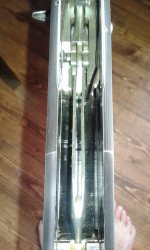Pond James Pond
New member
Attached is a picture of the inside of my late grandfather's autoloader 12g.
It is a Verney Carron from the 60's and is a clone of the Franchi automatic.

If you can tear your gaze away from the toes on the edge of the picture, you should be able to see inside the receiver. There, you can see a single metal component that has two parallel metal bars. This item connects the bolt assembly to the bolt return spring in the stock. The central channel is there so that the hammer can travel in that gap to hit the firing pin.
My concern is that, about a third of the way down from the bolt, the right hand side metal bar has a slight kink in it.
I don't know if this has always been there, but I know that I have fired only about 4-5 cartridges through it.
At the time I did not know the gun well and had only lubed what I could access through open breeches and other holes. The action had moved nonetheless, but perhaps a hottish load (they felt hot in that 3kg gun!) may have over powered that component. Or it's been like that for decades.
So my only question is should I get a metal shop (no smiths around here that I know of) to straighten it or not?
If yes, should they just press it straight somehow or is the use of heat OK on such a component?
Thanks.
It is a Verney Carron from the 60's and is a clone of the Franchi automatic.
If you can tear your gaze away from the toes on the edge of the picture, you should be able to see inside the receiver. There, you can see a single metal component that has two parallel metal bars. This item connects the bolt assembly to the bolt return spring in the stock. The central channel is there so that the hammer can travel in that gap to hit the firing pin.
My concern is that, about a third of the way down from the bolt, the right hand side metal bar has a slight kink in it.
I don't know if this has always been there, but I know that I have fired only about 4-5 cartridges through it.
At the time I did not know the gun well and had only lubed what I could access through open breeches and other holes. The action had moved nonetheless, but perhaps a hottish load (they felt hot in that 3kg gun!) may have over powered that component. Or it's been like that for decades.
So my only question is should I get a metal shop (no smiths around here that I know of) to straighten it or not?
If yes, should they just press it straight somehow or is the use of heat OK on such a component?
Thanks.

